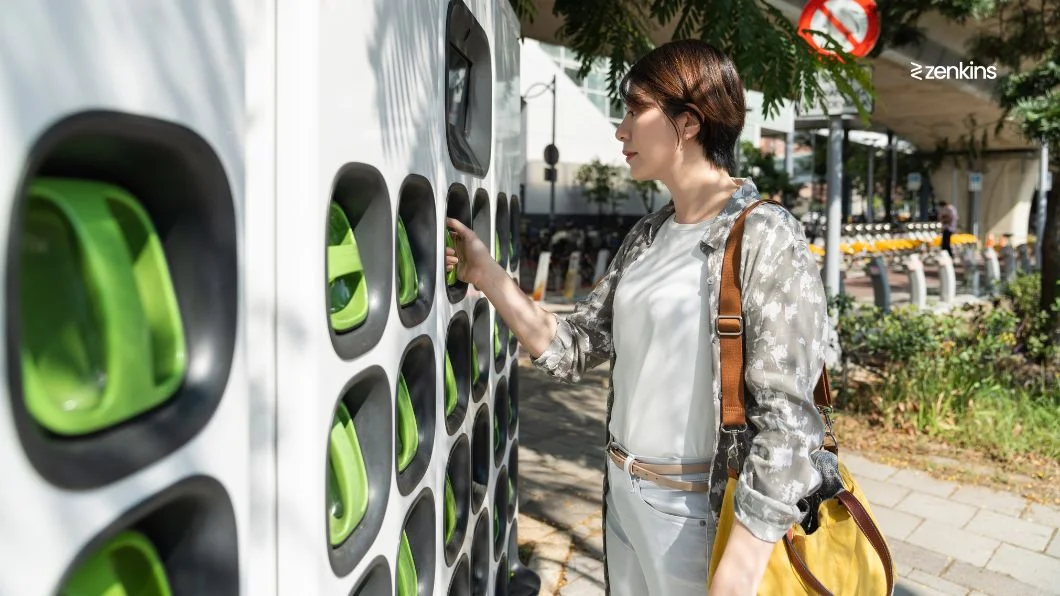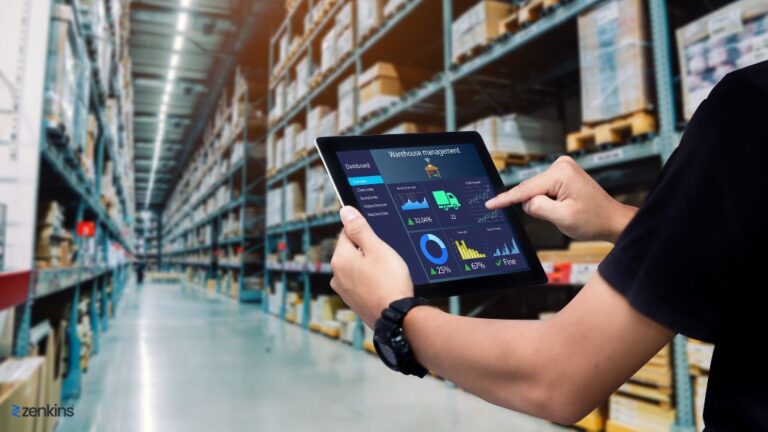Table of Contents
Case Study: Building a Next-Generation Battery Management System (BMS) with Zenkins Using the Microsoft Technology Stack
1. Introduction
Key focus: Introduce the problem, the client’s needs, and how Zenkins was approached for the solution.
As the electric vehicle (EV) industry grows, the demand for high-performance, efficient, and reliable Battery Management Systems (BMS) is at an all-time high. A well-designed BMS is crucial to ensuring the safety, longevity, and efficiency of electric vehicle batteries, which are the most critical and expensive components of any EV.
A leading automotive company approached Zenkins to develop a cutting-edge Battery Management System that could optimize battery performance, extend battery life, and offer real-time diagnostics using the Microsoft technology stack. The client needed a solution that could integrate seamlessly with their EVs and offer scalability to meet future demands.
In this case study, we delve into the challenges, solutions, and outcomes of this innovative project.
2. Project Overview
Key focus: Provide a high-level overview of the project and Zenkins’ role.
Client: A major player in the electric vehicle manufacturing industry.
Industry: Automotive, Electric Vehicles
Project: Development of an advanced Battery Management System (BMS) leveraging the Microsoft technology stack, including Azure, .NET Core, and Microsoft SQL Server.
Objective:
- To build a scalable, robust, and secure BMS that optimizes battery performance, monitors health, and provides real-time diagnostics.
- To enable integration with other vehicle systems (charging, autonomous driving, etc.) and ensure the software could handle large amounts of data in real-time.
Solution Provided by Zenkins: A comprehensive BMS software solution built using Microsoft’s ecosystem, delivering key features such as battery performance monitoring, predictive maintenance, fault detection, and data analytics.
3. Challenges Faced
Key focus: Discuss the technical and business challenges encountered during the project.
The development of a high-performance Battery Management System (BMS) for electric vehicles comes with a series of challenges:
- Real-Time Data Processing:
EV batteries generate vast amounts of data, including temperature, voltage, state of charge (SOC), and current. The BMS needed to process this data in real-time, ensuring that the vehicle’s battery was always functioning optimally. - Scalability:
The client required a BMS that could scale with their growing fleet of electric vehicles. The system needed to be flexible enough to accommodate additional functionalities, battery configurations, and emerging technologies. - Battery Safety and Fault Detection:
Managing battery safety is critical, as overcharging or overheating can lead to battery damage or even fire. The BMS needed to be equipped with advanced fault detection and diagnostic capabilities to identify potential issues before they became critical. - Predictive Maintenance:
Predicting battery degradation and failures before they happen was a key requirement. The client wanted to reduce maintenance costs by predicting when a battery would need service, thus minimizing downtime. - Integration with EV Ecosystem:
The BMS had to integrate seamlessly with other vehicle systems such as charging infrastructure, vehicle-to-grid (V2G) communication, and autonomous driving features.
4. Zenkins’ Solution
Key focus: Break down the specific solutions Zenkins implemented using the Microsoft technology stack.
4.1 Technology Stack
To meet the client’s needs, Zenkins selected the Microsoft technology stack as the foundation for the BMS. This included:
- Azure IoT Hub: For real-time data collection and communication between the vehicle’s battery and the cloud-based BMS.
- .NET Core: To build a robust and scalable backend system for processing real-time battery data.
- Azure Functions: For implementing serverless functions that handled specific tasks such as fault detection and data processing.
- Microsoft SQL Server: To store and manage vast amounts of battery data.
- Power BI: For data analytics and reporting, enabling the client to monitor battery health, performance, and predict potential failures.
4.2 Real-Time Data Processing with Azure IoT Hub
The heart of the BMS was the real-time processing of data generated by the EV’s battery. Using Azure IoT Hub, Zenkins enabled seamless communication between the battery and cloud services. This allowed for:
- Real-Time Monitoring: Data such as voltage, current, temperature, and SOC were continuously sent to the cloud for real-time monitoring.
- Dynamic Response: The system was designed to respond dynamically to changing battery conditions, automatically adjusting power output or initiating cooling measures when necessary.
4.3 Battery Performance Monitoring and Optimization with .NET Core
Using .NET Core, Zenkins built a highly performant backend system capable of managing and optimizing battery performance. This included:
- Energy Management Algorithms: Custom algorithms were developed to optimize energy use across the vehicle, ensuring maximum efficiency.
- Thermal Management: The BMS software monitored battery temperature and adjusted the vehicle’s cooling systems to maintain an optimal thermal environment.
- State-of-Health (SOH) Calculations: The system calculated the battery’s state of health in real time, providing insights into overall battery condition and longevity.
4.4 Predictive Maintenance Using Machine Learning
One of the most critical features of the BMS was its ability to predict battery degradation and potential failures. Zenkins implemented predictive analytics using Azure Machine Learning:
- Predictive Models: Machine learning models were developed to predict battery degradation based on usage patterns, environmental conditions, and real-time data.
- Preventive Alerts: When the system detected that a battery was likely to fail soon, it sent preventive maintenance alerts to the vehicle’s control center.
- Minimizing Downtime: By predicting battery health issues in advance, the client could minimize vehicle downtime and reduce maintenance costs.
4.5 Fault Detection and Diagnostics with Azure Functions
Battery safety was paramount, and Zenkins addressed this with advanced fault detection and diagnostics capabilities:
- Real-Time Fault Detection: Zenkins used Azure Functions to create serverless workflows that constantly monitored battery health and triggered alerts when faults were detected.
- Remote Diagnostics: The system allowed technicians to diagnose battery issues remotely, reducing the need for manual inspections and speeding up repairs.
- Self-Healing Mechanisms: In some cases, the BMS could initiate corrective actions autonomously, such as reducing power output or adjusting charging settings to prevent further damage.
4.6 Seamless Integration with EV Ecosystem
A key requirement of the project was to integrate the BMS with the wider EV ecosystem, including:
- Charging Infrastructure: The BMS integrated with charging stations, optimizing charging cycles to extend battery life and reduce charging time.
- Vehicle-to-Grid (V2G) Communication: The system was designed to support V2G communication, allowing the vehicle to provide energy back to the grid during peak demand.
- Autonomous Driving and ADAS Integration: The BMS also integrated with the vehicle’s autonomous driving systems, ensuring that battery performance and safety were aligned with the vehicle’s overall operation.
5. Development Process
The development of the Battery Management System was a collaborative process, involving close coordination between Zenkins and the client. Below is an overview of our development journey:
- Requirement Gathering and Analysis
We began by conducting in-depth consultations with the client to understand their specific needs, operational goals, and challenges. This phase allowed us to define clear objectives and requirements for the BMS, including integration with the EV architecture, safety protocols, and real-time monitoring capabilities. - System Design and Architecture
Using the Microsoft technology stack, we designed a flexible and scalable system architecture that could adapt to different battery configurations and EV models. The architecture was designed to ensure real-time performance, with high priority given to safety features and fault tolerance. - Development and Integration
The core development was carried out using .NET Core and Azure, with different components such as real-time monitoring, fault detection, and data analytics developed in parallel. We ensured smooth integration between the BMS and other vehicle systems, using industry-standard communication protocols. - Testing and Validation
Once development was complete, we conducted rigorous testing of the BMS under various conditions, including different battery loads, temperature extremes, and simulated faults. We worked closely with the client’s engineers to validate that the system met all safety and performance benchmarks. - Deployment and Support
The BMS was successfully deployed across multiple EV models, and our team provided continuous support to monitor system performance and address any post-deployment issues. Our OTA update capability allowed for smooth implementation of new features and security patches.
6. Key Results and Impact
Key focus: Highlight the results, including how the solution impacted the client’s operations and business.
The implementation of the Battery Management System (BMS) solution had a significant positive impact on the client’s operations. Some of the key benefits achieved include:
Increased Battery Lifespan
Thanks to real-time monitoring and predictive maintenance, the client saw a 15% increase in battery lifespan across their fleet. The optimized charging cycles and early fault detection allowed for better battery management, reducing wear and tear.
Reduction in Downtime
With predictive analytics in place, the system was able to alert the client about potential battery issues before they became critical. This proactive approach resulted in a 30% reduction in vehicle downtime, leading to higher fleet availability and productivity.
Improved Safety
The BMS ensured that battery conditions were always within safe operating ranges, minimizing the risk of overheating or battery failures. The client reported zero safety incidents related to battery malfunction after deploying the system.
Scalable Solution
The client’s fleet grew by 25% within a year of implementing the BMS, and the system scaled effortlessly to accommodate the additional vehicles without any performance issues.
Data-Driven Insights
The client was able to leverage Power BI dashboards to gain valuable insights into battery performance, helping them make data-driven decisions. These insights enabled them to optimize routes, improve vehicle efficiency, and enhance overall operational effectiveness.
7. Key Features of the Battery Management System (BMS)
The resulting BMS developed by Zenkins offered a range of cutting-edge features that addressed the client’s needs and surpassed industry standards:
- Real-Time Monitoring and Diagnostics
Our BMS solution allowed for real-time tracking of key parameters such as voltage, temperature, and state of charge (SOC). The system continuously monitored battery conditions and flagged any anomalies. Built-in diagnostic tools provided insights into the health of each cell, allowing technicians to pinpoint issues accurately. - Dynamic Battery Balancing
The BMS included an active balancing system, which redistributed charge between cells to ensure equal usage and extend battery life. The system optimized power distribution, preventing individual cells from becoming overcharged or undercharged, which could lead to reduced performance or premature failure. - Fault Detection and Safety Protocols
Zenkins integrated fault detection mechanisms to identify potential issues such as overvoltage, undervoltage, and overcurrent conditions. If any faults were detected, the system would initiate a series of emergency protocols, including controlled shutdown and isolation of the affected cells. This helped prevent dangerous situations such as thermal runaway. - Predictive Maintenance and Analytics
By integrating Azure AI and Microsoft Power BI, the BMS provided advanced analytics on battery usage patterns and health. The predictive maintenance system used machine learning models to forecast potential battery failures, allowing for timely intervention and reduced downtime. - Over-the-Air (OTA) Updates
Our solution allowed for seamless OTA updates, ensuring that the BMS could evolve over time. This capability made it possible for the client to push firmware updates, add new features, and enhance security without requiring the vehicle to be taken offline or into a service center. - Enhanced Communication and Integration
The BMS was designed to communicate efficiently with other critical EV systems such as the Vehicle Control Unit (VCU) and the Power Management System (PMS). The use of Azure IoT Hub enabled secure and efficient communication between the in-vehicle systems and the cloud infrastructure, ensuring the EV was always operating optimally.
8. Future Outlook and Next Steps
As electric vehicles continue to evolve, the demands on Battery Management Systems (BMS) will grow more complex, requiring advanced technology and continuous innovation. For the client, the successful implementation of this scalable, data-driven BMS is just the beginning of a transformative journey in electric vehicle software development. Here’s a look at the future of this project and the key advancements that will shape its next phase.
1. Integration of Artificial Intelligence and Machine Learning
While predictive maintenance and fault detection are already being powered by Azure Machine Learning, the client plans to further harness AI and ML to optimize battery performance dynamically. By learning from real-time data and usage patterns, future iterations of the BMS will:
- Enhance Efficiency: AI models will dynamically adjust power distribution and charging cycles to improve energy efficiency and extend battery life.
- Advanced Fault Prediction: More sophisticated machine learning algorithms will enable earlier and more accurate detection of potential battery issues, minimizing downtime and reducing operational costs.
- Self-Learning Systems: The BMS will evolve to become a self-learning system, autonomously improving its performance as it gathers more data over time.
2. Expansion to Solid-State and Next-Gen Batteries
The client is also exploring the integration of the BMS with solid-state batteries and other emerging battery technologies. These batteries promise higher energy density, faster charging times, and longer life cycles, but they also introduce new complexities in terms of thermal management and energy distribution. As the BMS evolves, Zenkins will ensure seamless integration with next-gen battery technologies, making the client’s system future-proof and adaptable to industry changes.
3. Enhanced Vehicle-to-Grid (V2G) Capabilities
Another focus area for the client is expanding Vehicle-to-Grid (V2G) technology. By allowing EV batteries to feed electricity back into the grid, this technology can turn the vehicle fleet into a flexible energy source. The next version of the BMS will support V2G integration by:
- Managing Bi-Directional Charging: Enabling vehicles to store and supply energy to the grid during peak demand periods, offering additional revenue streams for the client.
- Smart Energy Management: Optimizing when and how the vehicle batteries interact with the grid to ensure energy is used efficiently and costs are minimized.
4. Expanding Fleet Management Features
As the client’s electric vehicle fleet continues to grow, the BMS will evolve to provide even more comprehensive fleet management features. This will include:
- Fleet-Wide Predictive Analytics: Advanced algorithms that analyze battery performance across the entire fleet, providing insights on optimal maintenance schedules, route planning, and battery utilization.
- Real-Time Fleet Monitoring: Enhanced dashboard features that give the client real-time data on the performance of each vehicle, including battery health, charge status, and fault detection.
- Scalability Across Geographies: With plans to expand the client’s fleet internationally, the BMS will be designed to scale seamlessly across different regions, ensuring consistent performance and data insights globally.
5. Improved Cybersecurity
As electric vehicles become more connected, the threat of cybersecurity breaches grows. Future updates to the BMS will focus heavily on:
- Enhanced Encryption Protocols: To protect vehicle data from unauthorized access, stronger encryption algorithms will be implemented.
- Real-Time Threat Detection: Machine learning models that detect potential security threats in real-time, enabling rapid response and mitigation of risks.
- Compliance with Emerging Standards: The client’s BMS will remain compliant with new regulations and standards governing EV software and data security, ensuring robust protection of all systems.
6. Expansion into Autonomous Driving
With the growing interest in autonomous electric vehicles, the BMS will play a pivotal role in powering Advanced Driver Assistance Systems (ADAS) and fully autonomous driving capabilities. Future iterations of the BMS will integrate:
- Seamless Communication with ADAS Systems: Ensuring that energy is efficiently managed between autonomous systems and the vehicle’s core functions.
- Optimized Power Allocation for Self-Driving Features: Prioritizing battery resources to enable longer autonomous driving ranges while maintaining safety and performance.
7. Continuous Over-the-Air (OTA) Updates
One of the major benefits of the Microsoft technology stack is the ability to implement over-the-air (OTA) updates, ensuring the BMS remains up-to-date without requiring manual intervention. Moving forward, the client will:
- Push Regular Software Updates: Including bug fixes, security patches, and feature enhancements.
- Roll Out New Features: Such as AI-driven performance optimizations and real-time monitoring tools.
- Ensure Global Consistency: OTA updates will allow the client to maintain a consistent BMS system across its growing international fleet.
Next Steps: Preparing for Growth and Innovation
As the client continues to expand its EV offerings and technological footprint, Zenkins will remain a trusted partner, guiding them through the complexities of Battery Management System (BMS) development. The roadmap ahead includes several strategic next steps:
- Pilot New Battery Technologies: Implementing pilot programs with solid-state and other advanced batteries to test the BMS’s adaptability.
- Leverage AI for Autonomous Learning: Deploying machine learning models that self-improve over time, enabling smarter, more efficient battery management.
- Expand Geographic Reach: Scaling the BMS to support fleets across multiple continents, ensuring consistent performance regardless of regional differences in infrastructure.
- Invest in V2G and Smart Charging: Building out the client’s V2G capabilities to turn their EV fleet into a dynamic asset for the power grid, while also developing smarter charging solutions that minimize energy costs.
Conclusion: Paving the Way for a Sustainable and Autonomous Future
The future of the client’s electric vehicle business is bright, and their Battery Management System (BMS) will be a cornerstone of that future. As the automotive landscape evolves with new battery technologies, autonomous driving capabilities, and the rise of smart energy systems, Zenkins will continue to support the client with cutting-edge solutions built on the Microsoft technology stack.
With a focus on innovation, scalability, and security, Zenkins is committed to delivering solutions that not only meet the needs of today but also anticipate the challenges and opportunities of tomorrow. The client is well-positioned to remain a leader in the electric vehicle space, and the evolving BMS will be a key enabler of their continued success.




